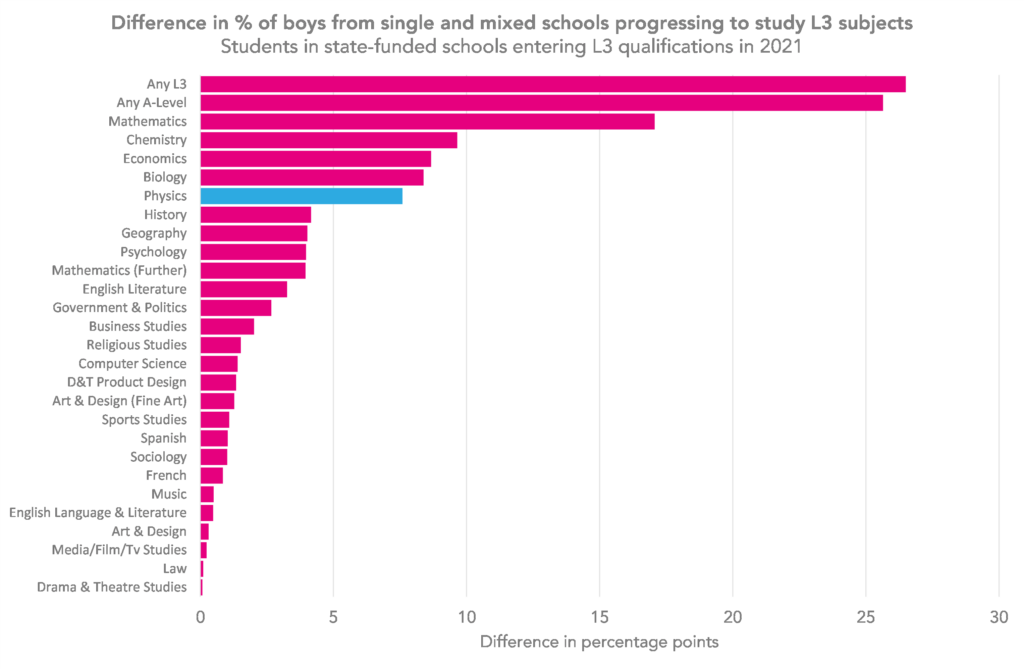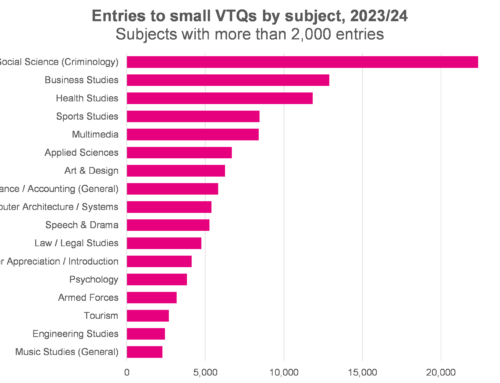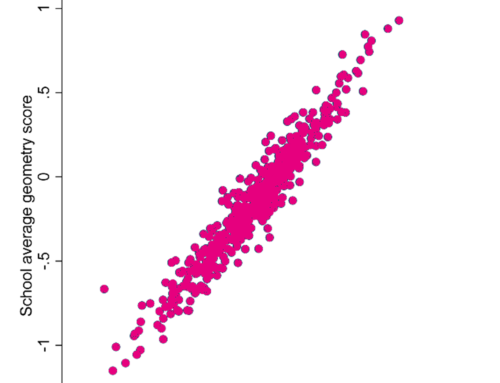We reposted this blog on X in March 2024 to mark International Women’s Day. Please feel free to comment below sharing your experiences and reflections on gender balance in physics.
Those of you who have followed my previous posts will know that I’m interested in the choices that students make at Key Stage 5. And – having spent many years at the Institute of Physics before joining Datalab – I’m particularly interested in A-Level physics.
Anyone who knows anything about A-Level physics probably knows it has an issue with gender balance (among other diversity issues). Just 22% of those who took the subject in 2021 were female. Only computer science had a lower proportion of female students.
But back at the Institute of Physics, we produced research showing that girls who attend single sex schools are far more likely to go on to study A-Level physics than those who attend mixed schools.
One possible explanation for the higher proportions in single sex schools choosing physics is that those taught in a single sex environment are less likely to see some subjects as being ‘for boys’ or ‘for girls’.
On the other hand, physics tends to be associated with high prior attainment. And pupils in single sex schools have higher attainment, on average, than those in mixed schools.
So is the higher rate of progression really anything to do with the single sex environment?
The situation
Let’s take a step back and see just how big the difference in progression is.
Of those female pupils who completed KS4 in a state-funded mixed school in 2019, 1.9% went on to enter A-Level physics two years later. This compares to 5.8% of girls in state-funded single sex schools.
So a fairly large difference – but then again, girls who went to a single sex schools are more likely to take any Level 3 qualification than those who went to mixed schools – just 56.9% of those in mixed schools go on to enter an L3 qualification, compared to 77.3% of those in single sex schools.
Let’s see how physics compares with some other subjects. I’ve included subjects that girls in single sex schools were more likely to access, with at least 1,000 entries from girls in mixed schools.

The difference in progression to physics is actually relatively small compared to some of the other STEM subjects, and even some subjects that tend to be more popular with female students, like psychology and English literature.
And, in yet another blow to my theory to pupils in single sex schools feel freer to make less gendered choices, boys in single sex schools are also more likely to choose STEM subjects and economics than those in mixed schools. 15.5% went on to enter A-Level physics, for example, compared to 7.9% of those in mixed schools.
Again, I’ve included subjects that boys in single sex schools were more likely to access, with at least 1,000 entries from boys in mixed schools.

Does attainment explain it all?
In an earlier post, I looked at what we can deduce about school entry requirements for different KS5 subjects. I found that almost all (96.9%) of those who entered A-Level physics held a grade 6 or above in either GCSE physics, or the equivalent in double science GCSE.
Pupils who do not achieve a grade 6 or above are unlikely to be able to progress. And there is a far lower proportion of these pupils in single sex schools. Among female pupils who completed KS4 in mixed schools, 27.0% achieved a grade 6 or above in GCSE physics or double science, compared to more than half (50.1%) of those in single sex schools.
In some cases, a single science GCSE in physics may be an entry requirement – 81.2% of A-Level physics entrants held one in 2021. And again – as we’d expect given their relatively high attainment – girls in single sex schools were far more likely to take triple science GCSE than their peers in mixed schools. 41.6% did so in 2019, compared to 26.4% of those in mixed schools.
On top of the differences in attainment, there are differences in pupil characteristics. Girls in single sex schools are less likely to be disadvantaged than those in mixed schools; 22.5% of girls who completed KS4 in single sex schools in 2019 had been eligible for free school meals at some point in the last six years, compared to 25.6% in mixed schools. They were also more likely to have English as an additional language (29.3% had EAL vs 14.9% in mixed schools), and over a third (37.8%) were located in London. Finally, they were far more likely to attend a selective school – 27.6% of female pupils in single sex schools did so, compared to just 1.4% of those in mixed schools.
Controlling for the differences
So what is the impact of completing Key Stage 4 in a single sex school on the likelihood of a girl going on to take A-Level physics?
I’ve estimated this by fitting logistic regression models to the data, both with and without controlling for differences in prior attainment and other characteristics.
The first model shows what the estimated impact is if we don’t worry about the differences in prior attainment, triple / double science GCSE and other characteristics. And the second the estimated impact if we do try to account for these differences.[1]

The impact is given in odds ratios, which can be a bit tricky to interpret. However, in this case, given that girls progressing to A-Level physics, is sadly, a fairly rare event, the odds ratios can be said to be roughly the same as the relative likelihood of girls in single sex schools going on to study A-Level physics.[2]
That might still sound a bit tricky to interpret. What I mean is that, if we ignore differences in attainment, likelihood of entering triple science, and other characteristics, the chances of a girl from a single sex school going on to enter A-Level physics are around 3.1 times higher than those of a girl from a mixed school.
But if we were to compare two girls with the same prior attainment and other characteristics, the one from a single sex school would only be around 1.3 times more likely to study A-level physics than the one from a mixed school.
So the differences in prior attainment and other characteristics explain almost all of the differences in progression to A-Level physics.
Summing up
I’ve often wondered if more single sex education might solve some of physics’s woes when it comes to gender balance at A-Level.
But – while it might make some difference – it looks as though most of the difference in progression from girls in single sex schools can be explained by looking at differences in attainment and pupil characteristics.
So the search for the silver bullet goes on.
[1] The model controlled for: grade in physics / double science GCSE, grade in maths GCSE, whether they took triple science, FSM6, EAL, region, school selectivity.
[2] Odds ratios are the ratio of the odds of two events occurring. In this case, they are the ratio of the odds of a girl from a single sex school entering A-Level physics, and a girl from a mixed school entering A-Level physics. Odds ratios only have the relatively straightforward interpretation described in the text when the events they are describing is rare.
Want to stay up-to-date with the latest research from FFT Education Datalab? Sign up to Datalab’s mailing list to get notifications about new blogposts, or to receive the team’s half-termly newsletter.









This is interesting work and much of it correlates with my own experience as a (male) A level Physics and university physics student 50 years ago, followed by a long career in university administration including aspects of admissions, and as a secondary school governor in England including for a single sex school (a boys’ school where there was a campaign to defend the local girls’ school from closure).
However, I do think the problem is also one of the nature of the premature overspecialisation of the A level qualification itself, that becomes particularly acute in genderisation in Physics and some other subjects.
I now live in Scotland (and am retired) and I note that the proportion of girls taking Higher level physics is significantly higher than that of those taking A level Physics in the data you quote.
One explanation is that the cliff-edge break between KS2 and KS3 does not exist in the Scottish education system and all schools have to offer a balanced curriculum including up to Higher Physics where it can be taken within a wider range of qualifications including those with a higher proportion of females. I don’t know the data in detail but I’ve seen a report that there are virtually no students in single sex state education in Scotland, so the relative gap between girls performance in Physics in Scotland compared to England is actually more significant if your findings are true. It also means that if single sex education is the solution, it’s a non-starter in Scotland.
Part of the difference between England and Scotland relates to the lower entry level for four year Scottish degrees along the European model, and the traditional split between a broad curriculum in the first two years of undergraduate curriculum and specialisation being concentrated into the last two years of ordinary and honours level.
However due to the fee/income differential between students from England and from Scotland and the cap on intakes of Scotland-domiciled, I feel that there are some significant pressures within Scottish universities to appeal to the England market that is leading to a tendence to overspecialise from year 2 for A level entry (just a hunch I haven’t researched it).
However participation in Higher Physics in Scotland from females is still too low and a report from Education Scotland in 2015 took up many of the recommendations of the Institute of Physics. I’m not up to speed on more recent data – and Covid will have had an effect on any subject with practical aspects recently. But I do feel looking more closely at the situation on a comparative basis could lead to more insight for strategies that might work across the UK state.
Sorry I meant the break between KS3 and KS4 of course lol. I’ve been 7 years in Scotland and forgotten all the England terms – taken this long to get my head round “Nat5”, “H”, and S5 and S6 (which is what it’s called in Scotland) … I remember Homer Simpson once said if you take on more knowledge you have to get rid of some old stuff ….
I do like a piece of Homer wisdom. https://www.youtube.com/watch?v=R1gDOyQDRxM
Would have been even better if I’d got my KS4 to KS5 right second time … doh!!
Homer would approve!
Hello! Thanks for this. I do suspect that the system is partly to blame and that things might look different if students studied a wider range of subjects at KS5. I personally think it would be a good idea to broaden the range of subjects for all sorts of reasons. But as you say, we still see imbalances under other systems even if they aren’t as extreme.
The comparison with Scotland is interesting. At Datalab, we tend to stick to analysis of what goes on in England largely because there’s more data available to researchers on pupils in England – so we tend to neglect these kinds of comparisons. Back at IOP, we did do some work on improving gender balance in Scotland. I think this was probably following the Education Scotland report that you mention, although it was too long ago for me to remember much about it! The approach that we favoured at the time was about challenging gender stereotypes across the board (not just sticking to what goes on in physics lessons) and working with feeder primaries etc. It still seems a sensible one to me, and likely to be a good idea with other benefits anyway.
But I do wish that we could find that silver bullet!
I’m not sure there is ever a silver bullet in education policy. These are interconnected systems that need to be regarded as a system as a whole, and not just within education but its inter-relationship with society as a whole. It’s not as simple as just pulling one lever and expecting everything to change – it needs a system-based holistic and iterative approach.
Comparative data between different education systems is notoriously difficult to analyse. I understand why you concentrate on England, but given the divergence between the education systems it would be good to see a few more attempts to both analyse Scottish education data and to at least acknowledge the differences. The UK government ministers seem to rely on PISA only in their attempts to rubbish the Scottish government, but as has been detailed elsewhere on this blog, PISA is methodologically unsound in selection of participants that may be unrepresentative of the overall population and is focussed on only one age group, one set of tests, has no longitudinal tracking and is only every five years. It undoubtedly has some value in comparing differences over long times between underdeveloped and developed economies and societies, but for the micro-measurement of differences of differences between the different education systems within the UK state it is as much use as chocolate teapot.
Education Scotland is in the process of being reformed by the Scottish Government and the SQA will be replaced in the near future. Now would be a good time to review the impact of the approach on female participation in Physics and other subjects, and work on implementing further recommendations. ‘A’ levels were only meant to be a temporary post war measure for up to 10% of the population. I do feel that unless they are ditched and replaced with a more grounded and less specialist system rather than tinkering England’s education will always be a challenge – but I suspect the idea of replacing it with a major move towards Scottish or European systems is politically unlikely at present.
Dear Natashe,
An interesting and complex question. I am currently a member of the senior management of a maintained girl’s school in East Ham (Plashet) and would be intrigued to know what the key factors are in removing the barriers for girls to progress in physics education and careers.
I do feel that there is an ingrained gender stereotype/bias towards physics being a “boys” subject, as perpetuated in popular media such as the “Big Bang theory” (excellent as it is).
There are two areas I would be interested in delving into:-
1) The “drag factor” of mixed gender schools; is the aggregate P8 score lower for girls in mixed schools compared to girls schools (specifically state schools and perhaps focussed on mid/high PAG KS2 students).
2) Is there a direct correlation between the school overall P8 score and the % of physics entries? (i.e. is the quality of teaching/school setting a significant factor) ?
Just a thought
Hi Steve, thanks for commenting and especially for sharing these areas of interest. I like the look of the second one particularly – I’d like to see this for all A-Level subjects. Sounds like I need to get working on another post!
I do agree about the ingrained gender stereotypes around physics (and other subjects). It’s a lot for schools to try and tackle on their own!
Hi Natasha,
This is really interesting data, and as you say there is no magic bullet that will solve the issue.
I work for the RSC and was really interested in the difference around the uptake of Chemistry in single sex schools and mixed schools, for both boys and girls (biology was surprising too). I will be sharing this with my team, and we may get in touch to discuss more about it.
Hi Chrissie, glad you liked it! Definitely feel free to get in touch, you can email us at educationdatalab@fft.org.uk.
I was the first girl in my school (many years ago) to take physics at A level. The teacher was sympathetic but had no understanding of the pressures I was under. For examle, if I went into the store room to get something, some of the boys would make commnts that I only went in there to hope that a boy would come in to chat me up. This is just an example – there was so much more.
This is depressing to hear – sorry you had to put up with that. I hope things have improved somewhat now but I fear this sort of thing may still be more common than we’d like to think. Actually I’d be interested to look at how common it is for schools / colleges to have just one girl studying physics…
60 years ago I was the first girl in the history of my school to take Physics at A level – I failed. My experience of, for example, doing a light experiment was that one of the boys said to another “she’s looking at herself in the mirror”. Another boy claimed to have seen the actual marks we got in “O” level and, despite both of us having the top grade, he claimed that his actual marks for Maths were higher. If in the Physics lab I went into the room with equipment I had to wait until there were no boys there because i would be accused of chasing them. I was in my 30’s when I decided to do my degree and become a Maths teacher. Even then I had one boy claiming that I needed to ask a male teacher to explain something to him because I needed to think how to put it simply enough for him to understand. Mind you, I have also had a man try to grab a working electric drill from my hand when I was doing something on the outside of my house. On the plus side, it was my father who gave me the electric drill possibly 40 years ago.
Another depressing story, thanks for sharing it. I dread to think how many girls dropped out or failed because of this sort of experience. And that’s just the few who were brave enough to take the subject in the first place, often as the first girl in their school to do so!
The experience of having a man grab a tool out of my hands is a familiar (and annoying) one to me BTW. I must ask my dad to get me a nice drill for my next birthday.
Hi Natasha,
I’d be interested to know if there is a difference for single sex schools when the data is further cut by
1. funding type – public/ grammar/ state funded
2. Selective vs non-selective.
3. Ethnic background.
with the caveat that the majority of single sex schools may fall in a single category, which in itself would tell us something.
Hmmm, good question. In this piece, I only looked at state-funded schools rather than public schools, and I did control for selectivity in the model mentioned at the end of the article. The majority of single sex schools are selective as you touch on. But I didn’t look at ethnic background at all here. I am planning a post on subject choice and ethnicity at some point soon, but the intersections of different characteristics (gender / ethnicity / disadvantage status) is something I’ve not really got into but would be very interested in.
I took A Level physics in the early 2000’s. There were 5 girls and 8 boys dong the AS. I got a B. All the girls except me dropped it for A2. In part because our two male teachers made it clear that girls don’t do physics and they preferred to work with the boys – all of whom were very high achievers. As someone who can do the maths, but not quickly and needed support I only got an E in the A2. I stuck it out because I am Blo*dy minded.
I continued privately with my love of physics and I now teach physics in a mixed school. I avoid A Level like the plague. I work hard to tell everyone they can do physics. Mostly people walk in my room with a Nope attitude because physics is the hardest thing ever. Fighting that is hard. Doubly so in girls, who now seem more interested in tictock and looks to learn.
The difference between GCSE physics and A Level physics is huge. Ridiculously so. My linked A level college doesn’t like to take any physicist who is not also doing Maths and a second science which caps lots of people with a love of physics, but issues with abstract maths. There is no time to supports these students, nor is there a physics option that is less obtuse maths and more fun.
At GCSE there needs to be a re-write:
Is science a cord subject or not. It cannot be only a core when you want it to be, but not give the support as English and Maths are more important.
The maths and physics curriculum needs to be reviewed. I don’t have time to teach the maths they need prior to the physics because they need the skills for me first, so it is all a bit of a mess.
Changing the maths methodolgy and terminology doesn’t help in science who use the ‘old’ ways.
Equation memorisation needs to be scrapped – every adult I know just looks stuff up.
More teachers are needed to keep continuity. I have lost my year 9’s into 10’s so I can keep my 10’s into 11’s. Then I pick up a lot of ks3 who are just slotted in anywhere. But as we have to all work to a 100% TT that is never going to happen.
Moving all of my A Level content into the GCSE has just made the GCSE and A Level inaccessible to most. So no wonder people want to quit it asap.
Who on earth had the bright idea to make space physics Single science and electromagnetism compulsory. Which one is more likely to be of interest?
But these are just my ponderings on things 🙂